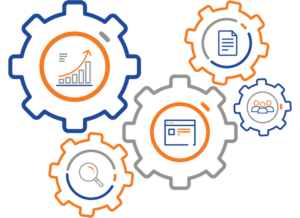There is a tendency to link the idea of “process” to operational excellence. And it’s true: Operational efficiency often lives and dies in the process. But the implications of process management, and more specifically process automation, are far more than just improvements to operations. New process initiatives enable new capabilities, which enables new revenue streams, which in turn opens up the possibility for yet more initiatives.
The compounding positive effects of process automation run deep and wide. But it’s important to understand, this isn’t necessarily a function of the automation itself. More often than not, it’s a function of strategy. These kinds of results are only possible when there is a deliberate focus on an end-to-end, enterprise-wide approach.
The Role of Intelligent Automation

Most business leaders can easily understand how automating tasks will lead to improved efficiencies. Work has to get done day in and day out. If you can automate even one task in a day, it will surely bring improvements. But, be careful with this thinking. These initial projects may add some efficiencies, but they can only contribute so much.
The primary issue is that this approach solves problems in siloes. While you will gain some productivity, you’ll lose out on coordinated opportunities. This limited focus on task functions also limits potential and ignores business outcomes. It is the equivalent of changing out one tire on a vehicle for a high-performance tire. Unless you also upgrade the other three tires, how much good have you really done?
Intelligent automation, on the other hand, is greater than the sum of its parts. It is focused not on improving individual tasks, but rather, on driving value in a way that creates better business outcomes across the board. Intelligent automation features a variety of buzzworthy technologies, all worth exploring. But for it to be transformatively impactful, automation technology must be part of an outcome-driven strategy. Single implementations aimed at specific functions serve only as minor, temporary improvements, distracting us from the real goals at hand.
The Importance of Orchestration

Another reason to take a centralized, enterprise-wide approach: bot and service orchestration. When we say “orchestration,” we are talking about managing all the interactions between your human employees and the digital workforce of RPA bots, as well as the systems they both use.
To get the most out of process automation, your platform should allow for seamless, natural interactions with legacy systems. People will be using these systems every day to send emails, move files, share documents and the like. So, there must be thoughtful integration for where the automation bot picks up the task and becomes part of the process. The idea is to reduce the volume of repeatable, low value tasks humans have to do, and transfer this menial but time-consuming workload to automated bots. The only way to do this effectively is from a 30,000-foot view that considers business outcomes for the entire organization.
At EPSoft, we believe these are two key aspects of elevating human potential, which is why they’re at the heart of our platform and part of our approach to business process automation. Want to learn more? Whether you’re already rolling with process automation or looking for help to get started, the EPSoft team is here to help.

